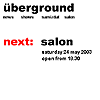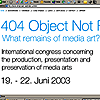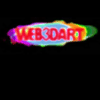 This
is
an
open
and
free
invitation
to
attend
the
opening
of
the
Uberground
Salon
in
Rotterdam
this
Saturday
05/24/03
starting
18:30
at
UBERGROUND,
Gedempte
Zalmhaven
923,
Rotterdam
downtown
Rotterdam,
near
by
the
Erasmus
bridge,
north
side.
This
is
an
open
and
free
invitation
to
attend
the
opening
of
the
Uberground
Salon
in
Rotterdam
this
Saturday
05/24/03
starting
18:30
at
UBERGROUND,
Gedempte
Zalmhaven
923,
Rotterdam
downtown
Rotterdam,
near
by
the
Erasmus
bridge,
north
side."Uberground is a new art space and trans-cultural playground in Rotterdam, open for the public on a regular basis for shows and salon events." The theme of the salon is "computerfinearts.com, a net-art collection, 1999-2003" with guest Mr. Doron Golan, art collector and artist from New York CityUSA.
"Uberground events deal with new media, architecture, design, experimental art, theory, performance, music, social issues and things on or over the edge." The organizers would like to extend a further invitation to all curators and artists interested in organizing future events in Uberground."
:: Garrett Lynch ::
 404
object
not
found
is
a
congress
that
will
be
held
in
June
in
Dortmund
Germany).
The
subject
is
preservation
of
new-media
art,
and
as
the
name
suggests,
it
has
a
special
focus
on
the
net.
On
the
links
page
of
the
site,
there's
a
huge
list
of
URLs
pointing
to
online
digital
(art)
archives.
The
list
exists
through
rather
institutional-type
art
archives.
404
object
not
found
is
a
congress
that
will
be
held
in
June
in
Dortmund
Germany).
The
subject
is
preservation
of
new-media
art,
and
as
the
name
suggests,
it
has
a
special
focus
on
the
net.
On
the
links
page
of
the
site,
there's
a
huge
list
of
URLs
pointing
to
online
digital
(art)
archives.
The
list
exists
through
rather
institutional-type
art
archives.
When we talk about new media or net art presently, it is hard to say which work will be important or influential in the future. For that reason, I missed what's probably the most import archive on the 404 links list: the way back machine. This project tries to archive the whole Internet, has a very huge database and has a search engine where a lot of lost URLs can be found—e.g. old Rhizome and Nettime pages.
Unfortunately, this doesn't work for all URLs. For example, while talking with somebody recently about one of the pieces that inspired me to do interactive sound engines, I discovered that I wasn't able to find the particular work (made by FSOL) through Google, even though I could find dead links on some old sites that were pointing to the specific URL (http://raft.vmg.co.uk/fsol/) where the work had once been. So I went to waybackmachine.org and typed in that URL. Although I discovered some remnants of the site, the piece that I looked for wasn't available.
So, you can conclude that, though it is far perfect, the largest net archive is well worth a look when you are searching for something that seems to be lost, especially when you look for older works (1994/1995).
:: Peter Luining ::
 Entropy8Zuper!
has
created
a
set
of
abstract
filmic
narratives
called
Wirefire,
which
are
currently
being
featured
at
Computer
Fine
Arts.
The
first
project
was
launched
in
September
of
2000,
and
a
new
installment
has
been
added
to
the
ongoing
series
every
few
months
since
then.
When
one
enters
the
website,
a
random
narrative
is
presented;
all
installments
start
with
the
same
introduction
of
a
pixelated
hand
squeezing
a
nipple.
When
moving
the
mouse
around,
one
can
find
two
clickable
buttons.
One
button
offers
a
new
piece
at
random,
while
the
other
offers
the
list
of
all
movies
according
to
the
dates
when
they
were
made.
Entropy8Zuper!
has
created
a
set
of
abstract
filmic
narratives
called
Wirefire,
which
are
currently
being
featured
at
Computer
Fine
Arts.
The
first
project
was
launched
in
September
of
2000,
and
a
new
installment
has
been
added
to
the
ongoing
series
every
few
months
since
then.
When
one
enters
the
website,
a
random
narrative
is
presented;
all
installments
start
with
the
same
introduction
of
a
pixelated
hand
squeezing
a
nipple.
When
moving
the
mouse
around,
one
can
find
two
clickable
buttons.
One
button
offers
a
new
piece
at
random,
while
the
other
offers
the
list
of
all
movies
according
to
the
dates
when
they
were
made.Wirefire is yet another net project relying directly on cinematic language. One might even ask why these short movies should be considered net art at all when they are clearly in line with experimental film language. Would they not function much better in a film setting? The answers to these questions lie in the presentation itself. When one enters the project, a random narrative is offered. Once inside, one can choose directly or randomly from the database. The open-endedness of the presentation itself makes the project inherently net art; and because of their specific dependency on database logic,* the animations become further problematized. I suggest visiting the website several times. I usually analyze websites very quickly but Wirefire challenged me over and over again. The net project is painfully exquisite.
*See Lev Manovich. "The Database Logic," The Language of New Media, (New York: MIT, 2000) pp.218-243
:: Eduardo Navas ::
 "Lab
3D,"
an
exhibition
of
six
3D-based
installations,
is
currently
taking
place
at
the
"Cornerhouse"
in
Manchester,
England
and
runs
until
the
06/20/03.
The
exhibition
shows
some
cutting
edge
3D-based
art
works
and
gives
visitors
/
users
the
chance
to
"immerse
themselves
in
the
world
of
the
dimensionalized
Internet
and
the
landscape
of
the
computer
game."
"Lab
3D,"
an
exhibition
of
six
3D-based
installations,
is
currently
taking
place
at
the
"Cornerhouse"
in
Manchester,
England
and
runs
until
the
06/20/03.
The
exhibition
shows
some
cutting
edge
3D-based
art
works
and
gives
visitors
/
users
the
chance
to
"immerse
themselves
in
the
world
of
the
dimensionalized
Internet
and
the
landscape
of
the
computer
game."As part of the exhibition "Web3D Art 2003" "an international, juried show of 25 online projects from artists, researchers and students from more than 10 countries" is accessible to those who can't make it to the show to see the installation work. There isn't the usual techie created VRML worlds -- all savvy and no-style -- that one would usually expect to find -- a few very interesting pieces instead. Still I'm as convinced that this is the way the internet will go in the future as much as I'm convinced about the whole 'internet becoming [an] interactive TV thing,' which is very little.
:: Garrett Lynch ::